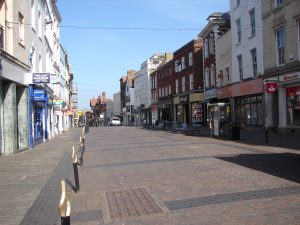 My husband and I travelled to Gloucester in 2012 with the goal of getting better insight into what the city was like in medieval times. I wanted to use it as the setting for Memento Mori, the third of my Lady Apollonia West Country Mysteries. Our preparations for that visit included study of British Online History as recommended by an English historian, Ian Mortimer. I had previously purchased the book, Historic Gloucester, by local historian, Philip Moss whom we were privileged to meet in person in 2012. Our preparation was helpful but being in Gloucester itself was invaluable. Walking the streets allowed us to begin to picture Gloucester in 1392 when my book, Memento Mori, was set.
My husband and I travelled to Gloucester in 2012 with the goal of getting better insight into what the city was like in medieval times. I wanted to use it as the setting for Memento Mori, the third of my Lady Apollonia West Country Mysteries. Our preparations for that visit included study of British Online History as recommended by an English historian, Ian Mortimer. I had previously purchased the book, Historic Gloucester, by local historian, Philip Moss whom we were privileged to meet in person in 2012. Our preparation was helpful but being in Gloucester itself was invaluable. Walking the streets allowed us to begin to picture Gloucester in 1392 when my book, Memento Mori, was set.
The present street pattern in the city centre, except for some of the street names, is much the same as it was in 1392 and goes back to Saxon times. The Saxons were influenced by the Roman layout of the city but did modify their street pattern somewhat. Many medieval buildings still exist in Gloucester, some in use and some in ruins. I have written in the last two months about monastic buildings and medieval churches, some of which we were able to see and visit on our walks.
At the same time, we tried to be aware of medieval buildings that no longer remain: churches, castles, and hospitals. One by one, these were torn down through the centuries. For example, Westgate Street is very impressive, but in medieval times, the upper part of that wide street was lined by buildings that no longer exist. This included several of the medieval churches that would have been active in the time of my novel. Note the width of modern Westgate Street in the picture above. It would have been much more crowded in 1392. The medieval Cross at the centre of the city where Westgate, Northgate, Eastgate, and Southgate Streets met was modified over the years and taken down in 1751 to provide more room for carriages. The East Gate was demolished in 1778 for the same reason. The North and South Gates soon followed.
Other ancient buildings which no longer survive are the Norman motte and bailey and the medieval castle, both of which were in the southwest part of the city. The Norman motte or hill was in the southwest corner of what had been the Roman city. Archaeology at that site has discovered a game of tables, the forerunner of backgammon, and is the oldest known surviving example of the game in the world. This Norman motte fortification was torn down when the medieval castle was constructed between the Norman site and the River Severn.
Gloucester’s medieval castle was a stone fortification with a keep in its centre. Interestingly, King Henry III, who had been crowned in Gloucester in 1216 was imprisoned in Gloucester Castle during the Baron’s War in 1263. By the time of my novel, the castle was in decline but was still used by the Sheriff of Gloucestershire as a gaol. I have referred to it in my story. It continued being used as a gaol until the 18th century when it was torn down.
Tags: Chaucer's England, historical fiction, medieval mysteries